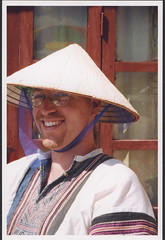Sky, tree and sunrise make my commute a thing of beauty.
Sunday, June 16, 2019
Monday, March 04, 2019
Walking for Scholars' Promise
Built around 1900 during the French colonial period in Vietnam, Long Bien Bridge was for many decades the only link across the Red River flowing through Hanoi. Today, while it still supports train traffic and a lot of motorbike traffic, it is less important as infrastructure but more important as an icon of Hanoi. Although bombed numerous times during war the bridge was never successfully destroyed, and stands today in its patched and repaired state as a testament to the power of determination (and as the start point of my Digital Learning Day Virtual 5K walk).
International students seeking access to an American education clearly face challenges. But there are also numerous pathways open to them. Digital learning, such as the American high school program offered entirely online by Scholars’ Promise, may be just the bridge you need to get you to your goal.
** ** ** ** **
"Train Street”
Along the viaduct supporting the rail line, the old stone arches have been filled in and designated an ‘art street’ for murals depicting old Hanoi. While the murals are full of nostalgia, many of the patrons are there to snap selfies, inserting themselves in these scenes from the past - and instantaneously posting them online, of course.
Curating our experience of the present seems a natural instinct, producing, you might say, an instant noodles variety of nostalgia. Speaking of which, you can also get noodles - along with all variety of street foods - served up on the sidewalk along this railroad. Which you might want to snap a picture of...
Leaving the railroad line, I walked past a small park where a statue of V. I. Lenin stands. The large plaza in front of the statue is a popular evening spot for skateboarders, while in the daytime it is mostly tourists stopping by to snap pictures. Across the street is a flag tower, part of the pre-colonial military fortress Thang Long Citadel, as well as the Vietnam Military History Museum featuring outdoor displays of American and French aircraft and military equipment, wrecked or abandoned in Vietnam during war or upon the departure of these forces.
And, by the way, this walk happened to fall on the second day of the summit, of which Hanoi was very proud of being chosen to host, between US President Trump and North Korea’s leader Kim Jong-un. Flags and signs adorned many parts of the city (the banners above say: "Vietnam: A Safe and Friendly Destination" and "Hanoi: A City for Peace") and there were soldiers and armored personnel carriers patrolling around the iconic French colonial era hotel in the city centre, the Metropole. (Which is not normal, by the way.)
** ** ** ** **
The end point of my walk, the Temple of Literature is considered the “first university” in Vietnam. Established in the 11th Century, today this is a park-like space with koi ponds and temple structures arranged in feng shui perfection, along with a giant bell and giant drum. I am not sure if the bell and drum were used to announce class opening back in the day (?) but in any case they are impressively large. The Temple is Literature is a tourism draw and includes souvenir shops, but is also the site of photo sessions by graduates and a place of pilgrimage for students about to take key exams.
The flanks of the compound are lined with large stone tortoises whose backs support stone markers engraved with the names of successful candidates within the rigorous academic mandarinate system under imperial Vietnam. After we are done discussing the virtues and flaws of that system, and of today’s education system here in Vietnam, and that in the West; those stone markers are still there, those names are still there, their efforts, aspirations and dreams are still memorialized in stone for today’s would-be scholars to draw inspiration from.
** ** ** ** **
My route:
Subscribe to:
Posts (Atom)
















